-
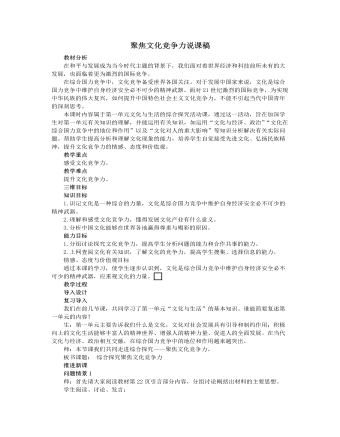
人教版高中政治必修3聚焦文化竞争力说课稿
(1)文化与经济、政治在经济基础上相互影响。①经济、政治和文化是社会生活的三个基本领域。其中,经济是基础,政治是经济的集中表现,文化是经济和政治的反映。一定的文化由一定的经济、政治所决定,又反作用于一定的政治、经济,给予政治、经济以重大影响。②经济发展是文化发展的基础。但这并不意味着文化的发展始终与经济的发展亦步亦趋。如同不能简单地把精神文明看作是物质文明的派生物和附属品一样,也不能简单地认为文化是经济、政治的派生物和附属品。文化有其自身的传承性和相对的独立性。那种认为只要物质条件好了,精神文化自然而然地就会好起来,物质条件差一点,精神文化就不可能搞好的观点,不符合历史发展的事实,是不正确的。③掀开历史的画卷,文化既有古今和地域之别,又有先进与落后、腐朽之分。不同的文化,对经济、政治的影响不同,对社会发展的作用也不同。不同民族的文化,影响不同民族和国家各具特色的发展道路。
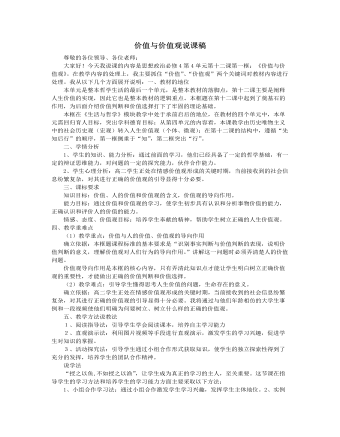
人教版高中政治必修4价值与价值观说课稿(一)
预测回答:成龙在影视,武术方面的价值,对于某个人,某个集团的价值。知识引导:人的价值体现在多方面的,可以是物质方面,也可以是精神方面,可以是对某个人或某个集团的价值,也可以是对人类和社会的价值。设置目的:从学生感兴趣的人物入手,分析对人的价值的评价。让学生自己分析总结,体现学生在新课改下的主体地位。从上述事例中我们可以看出人的价值是什么?如何评价?(学生活动)2.人的价值:在于创造价值,在于对社会的责任和贡献,即通过自己的活动满足自己所属的社会、他人以及自己的需要。(幻灯片显示)3.人的价值评价:看他的贡献,最根本的是对社会发展和人类进步事业的贡献。(幻灯片显示)老师总结:对社会的贡献并不是高高在上,不可触及。只要是做自己该做的事,从身边的小事做起,普普通通的劳动就是贡献社会和他人。学生归纳:人生价值原理二、价值观的导向作用(板书)1.价值观的含义人们在认识各种具体事物的价值的基础上,形成对事物价值的总的看法和根本观点。

人教版高中政治必修3体味文化说课稿
(二)引入内容1、播放幻灯片,从名言引出思考,什么是文化,如何理解文化?学生探究,既可质疑,也可谈自己对文化的理解2、幻灯片,以三组幻灯,分三个阶段,学生分别通过小组讨论的形式,归纳总结文化现象的三个特征3、根据对文化现象的认识,归纳总结文化的内涵及外延小活动:把不是文化的山、水、树,由几组同学画出来,体会文化的含义4、一组判断题,哪些是文化的,哪些不是5、理解文化的特点首先,根据前面,总结文化现象的特征,归纳出文化的普通性及特殊性其次,播放视频,归纳总结文化是人类特有的现象第三,根据教材材料,小组探究总结,文化是后天习得的第四,借助小活动的材料,归纳,文化需要一定的物质载体6、文化的作用首先、观看视频,小组探究总结,文化对于人的影响其次,观看视频,小组探究总结,文化对社会的影响
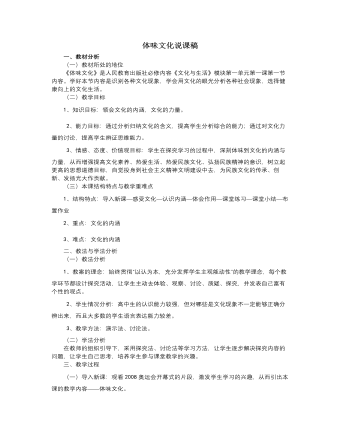
人教版高中政治必修3体味文化说课稿
3、文化的力量。为了使学生能辨证地分析文化的力量,我设计了两个问题进行探讨:(1)是不是任何文化都能起促进作用?(2)你在听或唱国歌时感受到一种什么样的力量?这样,学生在对比中学会辨证地分析文化的力量——先进的、健康的文化能促进社会发展和个人成长;落后的、腐朽的文化则阻碍社会发展和个人成长。同时还能提高学生的文化赏析能力,从而引导学生装自觉参加健康有益的文化活动,抵制不良文化的影响,投身到社会主义精神文明建设中去。关于课堂练习,我准备了5个针对性比较强的选择题,从而加深巩固本框题的重难点知识。最后,播放歌曲《走进新时代》,展示本课知识结构,指出本框题需重点掌握的问题,结束本课教学。课后作业,我设计了这样一个辨析的题目:文化是人们创造的全部财富的总和,它是人类特有的现象。
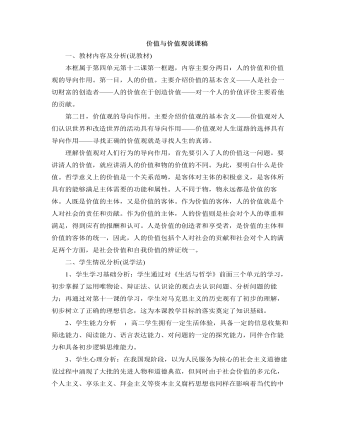
人教版高中政治必修4价值与价值观说课稿(二)
二、学生情况分析(说学法)1、学生学习基础分析:学生通过对《生活与哲学》前面三个单元的学习,初步掌握了运用唯物论、辩证法、认识论的观点去认识问题、分析问题的能力;再通过对第十一课的学习,学生对马克思主义的历史观有了初步的理解,初步树立了正确的理想信念,这为本课教学目标的落实奠定了知识基础。 2、学生能力分析 :高二学生拥有一定生活体验,具备一定的信息收集和筛选能力、阅读能力、语言表达能力、对问题的一定的探究能力,同伴合作能力和具备初步逻辑思维能力。3、学生心理分析:在我国现阶段,以为人民服务为核心的社会主义道德建设过程中涌现了大批的先进人物和道德典范,但同时由于社会价值的多元化,个人主义、享乐主义、拜金主义等资本主义腐朽思想也同样在影响着当代的中学生。

人教版高中政治必修4生活处处有哲学说课稿
(二)组织学生探究知识并形成新的知识。我从学生的生活体验入手,运用案例等形式创设情境呈现问题,使学生在自主探索、合作交流的过程中,发现问题、分析问题、解决问题,在问题的分析与解决中主动构建知识。主要通过几幅漫画让学生思考其中的哲学道理,开始接触哲学。漫画一:种瓜得瓜,种豆得豆,种鸡蛋得??漫画二:甲:下雨好极啦!乙:下雨糟透了!漫画三:——狂妄之徒,你竟然坏了祖上规矩!在引导学生思考、体验问题的过程中,可以使学生逐步学会分析、解决问题的方法。这样做既有利于发展学生的理解、分析、概括、想象等创新思维能力,又有利于学生表达、动手、协作等实践能力的提高,促进学生全面发展,力求实现教学过程与教学结果并重,知识与能力并重的目标。
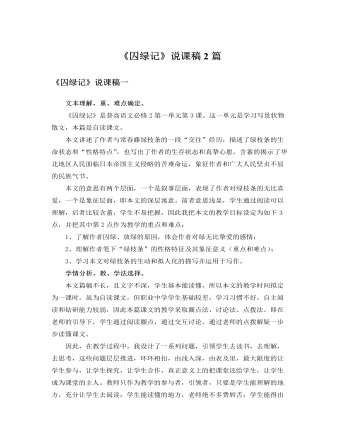
人教版高中语文必修2《囚绿记》说课稿2篇
“深入探究,把握主旨”这一步则是解决教学的重点难点,这里涉及到课文的深层意蕴,学生理解有难度,教师在通过问题引领学生探讨的基础上,还要适时启发、点拨,因为教学时间有限,让学生漫无边际的讨论,可能难以完成预定的教学任务,会使教学过程不完整。至于本文的写作特点的教学视时间而定,有时间可以让学生说一说,没有时间用小黑板出示一下,让学生了解就行,如果时间不够,甚至可以不讲。第三阶段是“延伸练习,巩固提高”。
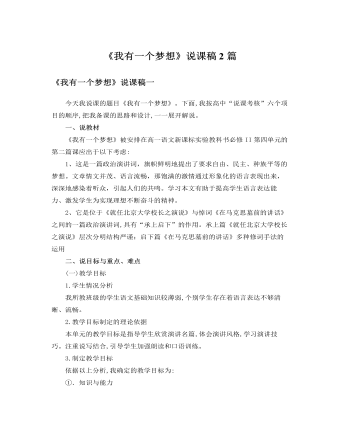
人教版高中语文必修2《我有一个梦想》说课稿2篇
(2).教学手段为了使我根据教材而设计的三个教学目标以及重点难点得以的突出和突破,达到最大化的展示境界,同时也为了配合以上我选择的四种教法得以完满实现,我决定采用“多媒体”教学手段进行全程教学。利用电脑的信息容量大,操作简便等优点,形象生动的直观展示教学内容,不但提高学习效率和质量,而且容易激发学生的学习兴趣和调动学习的积极性。四、说学法我为学生设计了三个学习方法:1.让学生学会在探究中学。通过“对黑人严酷处境的探究”和对文中重点语句的探究,培养学生在探究中学习的能力。2.让学生学会在读中学。通过“诵读法”指导学生在诵读过程中感受演讲词内在的魅力,学会在读中学。3.让学生学会在练习中学。通过“课外延伸练习法”,对所学的知识进行运用,培养学生的创新和自学能力。
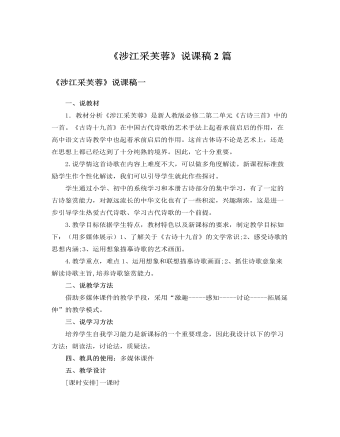
人教版高中语文必修2《涉江采芙蓉》说课稿2篇
一、说教材1.教材分析《涉江采芙蓉》是新人教版必修二第二单元《古诗三首》中的一首。《古诗十九首》在中国古代诗歌的艺术手法上起着承前启后的作用,在高中语文古诗教学中也起着承前启后的作用。这首古体诗不论是艺术上,还是在思想上都已经达到了十分纯熟的境界。因此,它十分重要。2.说学情这首诗歌在内容上难度不大,可以做多角度解读。新课程标准鼓励学生作个性化解读,我们可以引导学生就此作些探讨。学生通过小学、初中的系统学习和本册古诗部分的集中学习,有了一定的古诗鉴赏能力,对源远流长的中华文化也有了一些积淀,兴趣渐浓,这是进一步引导学生热爱古代诗歌、学习古代诗歌的一个前提。3.教学目标依据学生特点,教材特色以及新课标的要求,制定教学目标如下:(用多媒体展示)1、了解关于《古诗十九首》的文学常识;2、感受诗歌的思想内涵;3、运用想象描摹诗歌的艺术画面。
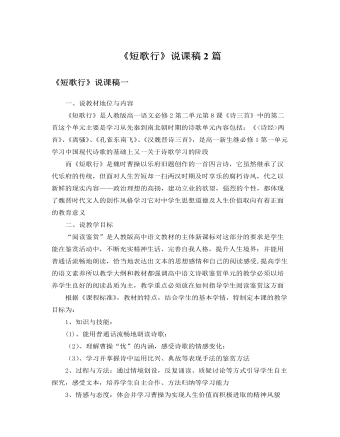
人教版高中语文必修2《短歌行》说课稿2篇
一、说教材《短歌行》是普通高中课程标准实验教科书必修(二)第二单元的一篇略读课文,本单元安排的是先秦到南北朝时期的诗歌。《短歌行》是著名政治家、军事家、文学家曹操的作品。诗中抓住“忧”字来写诗人为什么“忧”,如何解“忧”,从而表达希望能够招揽人才、完成统一天下的雄心壮志。所以本单元安排《短歌行》一诗,对学生全面了解曹操,感受曹操在短暂的人生中竭力创造伟业的气概。二、说学生我这一课的教学对象是高一学生。他们进入高中学习的时间只有三个多月,现在已经完成了必修(一)的学习。学习了现代诗歌单元,有了一定的诗歌学习基础,初步掌握了读诗的基本方法,但是还未能形成成熟的稳定的学习方式。同时,本单元学习是高中第一次接触古代诗歌,诗歌语言上的障碍和时间上的跨度对他们来说都是学习上的困难。因此教师要引导学生自主学习,合作学习,为他们设置新的学习情境,提供合作探究的机会。

人教版高中历史必修2罗斯福新政说课稿2篇
1、教材的地位作用本课是新人教版普通高中历史必修Ⅱ第六单元第18课的内容,阐述罗斯福新政的背景、措施、影响。从单元知识安排看,本课与第17课《空前严重的资本主义世界经济危机》、19课《战后资本主义的新变化》共同诠释第六单元课题——《资本主义世界经济政策的调整》。说明了“资本主义经济理论和政策随着资本主义发展而不断调整的特点”,凸显了“市场调节”和“国家干预”在经济发展中的重要性。从知识体系看,它是学生学习了第一次工业革命后自由资本主义、第二次工业革命后的垄断资本主义等之后出现的,既是对上述知识的巩固与综合运用,又为学生学习必修二的相关内容打下基础,有承上启下的作用。本课三个子目从逻辑上看又是递进关系。第一个子目“临危受命”承上启下,说明了罗斯福上台的历史背景具有临危受命的特点,第二个子目“实施新政”讲述了罗斯福新政的主要内容,第三个子目“摆托危机困境”主要讲述了罗斯福新政的影响。

人教版高中英语必修2Cultural Relics说课稿2篇
Ⅲ. Analysis of the teaching material:The topic of this unit is cultural relics. Students are quite interested in topics about different cultures around the world. This is the second period of the whole unit. As a reading class, the passage mainly talks about the history of the amber room (how it was made, sent as a gift, lost and rebuilt).According to the new national curriculum, when teaching reading, much emphasis should be put on training the students’ reading skills.Ⅳ. Teaching objectives1. Language objectives:1) Students are required to master the key words and phrases occurred in the passage (e.g. amazing, decorate, belong, in return, less than etc.)2) Students are required to learn the attributive clause and acquire the sentence pattern.2. 1) Students are required to describe a certain thing by using the new sentence patterns.2) Students are required to master two kinds of reading skills—skimming and scanning, and learn to use them in their daily reading.3. 1) Students are required to know the history of the amber room.2) Students are required to appreciate cultural relics and understand the importance of protecting them.Ⅴ. Teaching important and difficult points1) the new words, phrases, and sentence pattern in the course of reading.2) Teaching difficult point: Help the students master two kinds of reading skills—skimmingand scanning and learn to apply them in daily use.Ⅵ. Teaching methods:Task-based method & Top-down model Ⅶ. Teaching aids: PPT, pictures, blackboard Ⅷ. Teaching procedure:

人教版高中英语必修2The Olympic Games说课稿2篇
Purpose of my design:To ask the students to do these two tasks will make the Ss predict the story of this passage. As a result, it will deepen Ss’ memory of this story because they will have their own understanding of this story.Step 3. While-readingTask 1. (Individual work _____min)Skimming: ask students to skim the text and the main ideas of each paragraph in this passage. Please read it quickly and then match the sentences with the letters.Task 2. (Individual work _____min)Scanning: read the text quickly and decide the whether the following statements are true or false and give reasons.Task 3. (Pair work _____min)Listen to the tape and fill in the banks. Then read the paragraph with expression to your partner.Task4 (individual work min)Listen to the tape again and write down the main idea in one sentence.Purpose of my design: Enable students to understand the given material better by using different reading skills. And proper competition can arouse the Ss’ interest in English learning. “Task-based” teaching method is used here todevelop the Ss’ ability of communication and also their ability of co-operation will be well trainedStep 4. Post-readingTask 1. (Individual work, pair work, group work, class work; _____min)Discussion (group of 4):1. If you were Hippomenes, would you run against Atlanta?2. Do you think Hippomenes deserved to win the race? Why or why not?Step 5. HomeworkPlease read the story again carefully after class and imagine: What will happen during the race between Hippomenes and Atlanta? Who do you think will win the race? Do you think Atlanta would marry Hippomenes? Write an end for the story with thses questions.Purpose of my design: Homework is so important and necessary for to master the knowledge they learned after class. It will check whether the Ss achieve the teaching aims.Part 5 Blackboard design
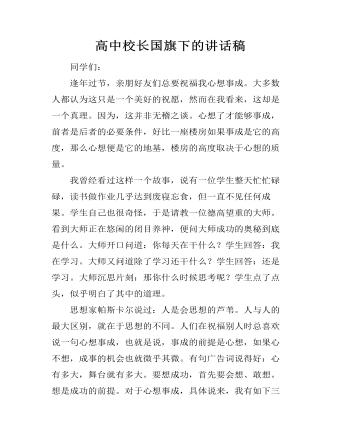
高中校长国旗下的讲话稿
同学们:逢年过节,亲朋好友们总要祝福我心想事成。大多数人都认为这只是一个美好的祝愿,然而在我看来,这却是一个真理。因为,这并非无稽之谈。心想了才能够事成,前者是后者的必要条件,好比一座楼房如果事成是它的高度,那么心想便是它的地基,楼房的高度取决于心想的质量。我曾经看过这样一个故事,说有一位学生整天忙忙碌碌,读书做作业几乎达到废寝忘食,但一直不见任何成果。学生自己也很奇怪,于是请教一位德高望重的大师。看到大师正在悠闲的闭目养神,便问大师成功的奥秘到底是什么。大师开口问道:你每天在干什么?学生回答:我在学习。大师又问道除了学习还干什么?学生回答:还是学习。大师沉思片刻:那你什么时候思考呢?学生点了点头,似乎明白了其中的道理。
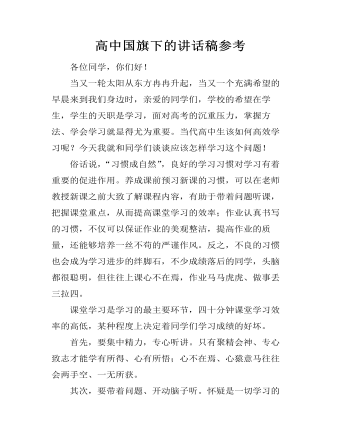
高中国旗下的讲话稿参考
各位同学,你们好!当又一轮太阳从东方冉冉升起,当又一个充满希望的早晨来到我们身边时,亲爱的同学们,学校的希望在学生,学生的天职是学习,面对高考的沉重压力,掌握方法、学会学习就显得尤为重要。当代高中生该如何高效学习呢?今天我就和同学们谈谈应该怎样学习这个问题!俗话说,“习惯成自然”,良好的学习习惯对学习有着重要的促进作用。养成课前预习新课的习惯,可以在老师教授新课之前大致了解课程内容,有助于带着问题听课,把握课堂重点,从而提高课堂学习的效率;作业认真书写的习惯,不仅可以保证作业的美观整洁,提高作业的质量,还能够培养一丝不苟的严谨作风。反之,不良的习惯也会成为学习进步的绊脚石,不少成绩落后的同学,头脑都很聪明,但往往上课心不在焉,作业马马虎虎、做事丢三拉四。课堂学习是学习的最主要环节,四十分钟课堂学习效率的高低,某种程度上决定着同学们学习成绩的好坏。首先,要集中精力,专心听讲。只有聚精会神、专心致志才能学有所得、心有所悟;心不在焉、心猿意马往往会两手空、一无所获。

新人教版高中英语必修3Unit 2 Morals and Virtues教学设计二
Activity 41. Students complete the task of activity 4, then teachers and students check the answers. 2. The teacher organized the students to work together and asked them to use the tables and mind maps sorted out before to retold the important choices in Lin Qiaozhi's life and their resultsStep 5 Language points1. The teacher asks the students to read the text carefully, find out the core words and long and difficult sentences in the text and draw lines, understand the use of vocabulary, and analyze the structure of long and difficult sentences. 2. The teacher explains and summarizes the usage of core vocabulary and asks the students to take notes. 3. The teacher analyzes and explains the long and difficult sentences that the students don't understand, so that the students can understand them better. Step 6 Homework1. Read the text again, in-depth understanding of the text; 2. Master the use of core vocabulary and understand the long and difficult sentences. 3. Complete relevant exercises in the guide plan. 1、通过本节内容学习,学生是否理解和掌握阅读文本中的新词汇的意义与用法;2、通过本节内容学习,学生能否结合文本特点总结林巧稚的人生原则和人格品质特征;3、通过本节内容学习,学生能否针对人生抉择发表自己的看法;能否全面地、客观地、理性地看待问题,进而对道德和人性有更加深入的思考和理解。

新人教版高中英语必修3Unit 2 Morals and Virtues教学设计三
The joke set her crying.这个玩笑使她哭起来。Step 5 ReadingActivity 31. Students read the small text in activity 3. The teacher provides several small questions to check whether students understand the content of the text and the ideographic function of the -ing form in the text.*Where are those people?*Why did Dr Bethune come to China?*How did he help the Chinese people during the war?*What did Chairman Mao Zedong say about him?2. Ss try to rewrite some sentences using the -ing form. Then check the answers. When checking the answers, the teacher can ask different students to read the rewritten sentences and give comments.Answers:1. he became very interested in medicine, deciding to become a doctor.2. …after hearing that many people were dying in the war.3. Helping to organise hospitals, he taught doctors and nurses, and showed people how to give first aid./ He helped to organise hospitals, teaching doctors and nurses, and showing people how to give first aid.4. …praising Dr Bethune as a hero to be remembered in China.Step 6 PracticeActivity 4Students complete grammar activities 2 and 3 on page 69 of the workbook.Step 6 Homework1. Understand and master the functions and usage of the -ing form;2. Finish the other exercises in Using structures.1、通过本节内容学习,学生是否理解和掌握动词-ing形式作宾语补足语语和状语语的功能和意义;2、通过本节内容学习,学生能否正确使用动词-ing形式描述人物的行为、动作及其经历;3、通过本节内容学习,学生能否独立完成练习册和导学案中的相关练习。

新人教版高中英语必修3Unit 2 Morals and Virtues教学设计四
3.Teachers ask different groups to report the answers to the questions and ask them to try different sentence patterns.The teacher added some sentence patterns for students to refer to when writing.Step 4 Writing taskActivity 51.Write the first draft.Students first review the evaluation criteria in activity 5, and then independently complete the draft according to the outline of activity 4, the answers to the questions listed in the group discussion and report, and the reference sentence pattern.2.Change partners.The teacher guides the students to evaluate their partner's composition according to the checklist of activity 5 and proposes Suggestions for modification.3.Finalize the draft.Based on the peer evaluation, students revise their own compositions and determine the final draft.Finally, through group recommendation, the teacher selects excellent compositions for projection display or reading aloud in class, and gives comments and Suggestions.Step 5 Showing writingActivity 5T call some Ss to share their writing.Step 6 Homework1. Read the passage in this section to better understand the passage.2. Carefully understand the hierarchical structure of the article, and deeply understand the plot of the story according to the causes, process and results;3. Independently complete the relevant exercises in the guide plan.1、通过本节内容学习,学生是否理解和掌握阅读文本中的新词汇的意义与用法;2、通过本节内容学习,学生能否通过人物言行的对比分析道德故事的深层内涵;3、通过本节内容学习,学生能否根据故事的起因、经过和结果来深入理解故事的情节,从而了解文章的层次结构;4、结合现实生活案例发表自己的见解和看法,写一篇观点明确、层次分明的故事评论。

新人教版高中英语必修3Unit 2 Morals and virtues教学设计一
(2) students are divided into groups according to the requirements of activity 3. Each student shares a story of personal experience or hearing-witnessing kindness, and then selects the most touching story in the group and shares it with the whole class. Before the students share the story, the teacher can instruct them to use the words and sentence patterns in the box to express. For example, the words in the box can be classified:Time order: first of all, then, after that, later, finally logical relationship :so, however, although, butTeachers can also appropriately add some transitional language to enrich students' expression:Afterwards, afterwards, at last, in the end, eventuallySpatial order: next to, far from, on the left, in front ofOtherwise, nevertheless, as a result, therefore, furthermore, in addition, as well asSummary: in a word, in short, on the whole, to sum up, in briefStep 8 Homework1. Understand the definition of "moral dilemma" and establish a correct moral view;2. Accumulate vocabulary about attitudes and emotions in listening texts and use them to express your own views;3. Complete relevant exercises in the guide plan.1、通过本节内容学习,学生能否理解理解“道德困境”的定义;2、通过本节内容学习,学生能否通过说话人所表达的内容、说话的语气、语调等来判断其态度和情绪;3、通过本节内容学习,学生能否针对具体的道德困境发表自己的看法和见解,能否掌握听力理训练中的听力策略。
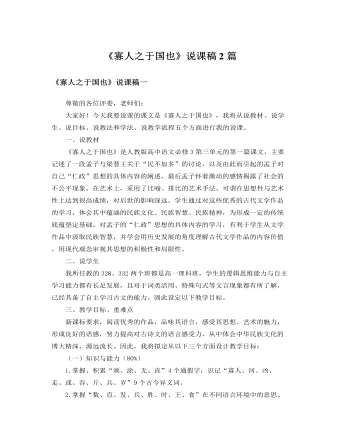
人教版高中语文必修3《寡人之于国也》说课稿2篇
(明确:“寡人之于国也,尽心焉耳矣”,但“寡人之民不加多,何也?”)②他认为自己对国家政务尽心尽力了,他有哪些具体做法?(明确:移民移粟)③第2—4节中孟子是怎样说明梁惠王移民移粟的措施与“邻国之政”并无本质区别的?(明确:孟子不直接回答“民不加多”的问题,而是用梁惠王熟悉的“战”设喻——设圈套,诱使对方在不知不觉中说出“不可,直不百步耳,是亦走也。”)④孟子认为怎样才能做到“王道之始”?要想“王道之成”还需采取哪些措施?(明确:“不违农时,谷不可胜食也。数罟不入氵夸池,鱼鳖不可胜食也。斧斤以时入山林,材木不可胜用也。谷与鱼鳖不可胜食,材木不可胜用五亩之宅,树之以桑,五十者可以衣帛矣。鸡豚狗彘之畜,无失其时,七十者可以食肉矣。百亩之田,勿夺其时,数口之家,可以无饥矣。谨库序之教,申之以孝涕之义,颁白者不负戴于道路矣。)这一小步的目的是想让学生通过这些问题的解答,可以进一步理清思路,掌握文的大概内容。

